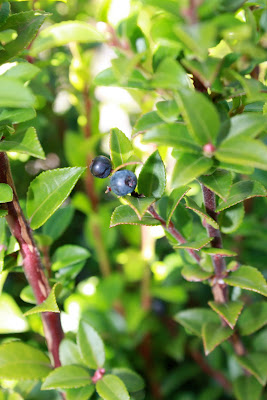Evergreen Huckleberry, Vaccinium Ovatum Pursh. Plant symbol=VAO2.
This is a very interesting, useful and aesthetically beautiful plant. Its rich, glossy, ovate leaves, which are usually 2-5cm in length, range in color from a deep lime green to a cool salmon pink/red, and are rich in vitamin C. This goes for the berries as well, which are best picked and eaten after the first frost in mid to late October, early November. The leaves and stems, when finely chopped, contain quinic acid that helps in the lowering and stabilization of blood sugar levels with diabetes. The flavor of the berry could be described as sweet, musky, and somewhat similar to Alaskan blueberry, but with an edge of black currant. (?) The plant itself can tolerate a wide range of light, from nearly full shade to full sun and still produce a strong yield of its delicious, edible berries. As far as i am concerned, this plant type is an excellent candidate for almost any landscape or garden. Mass plantings are highly encouraged.....
Throughout the spring summer season Evergreen huckleberry is available at a cost ranging from $9.75 for 1 gallon to $35.95 for 5 gallon with relatively short notice. Also, in the picking season, evergreen huckleberry berries, along with black huckleberries, most native blueberries and chanterelle mushrooms, will be available for $8.00 to $11.00 per pound, fresh, frozen or dried.








